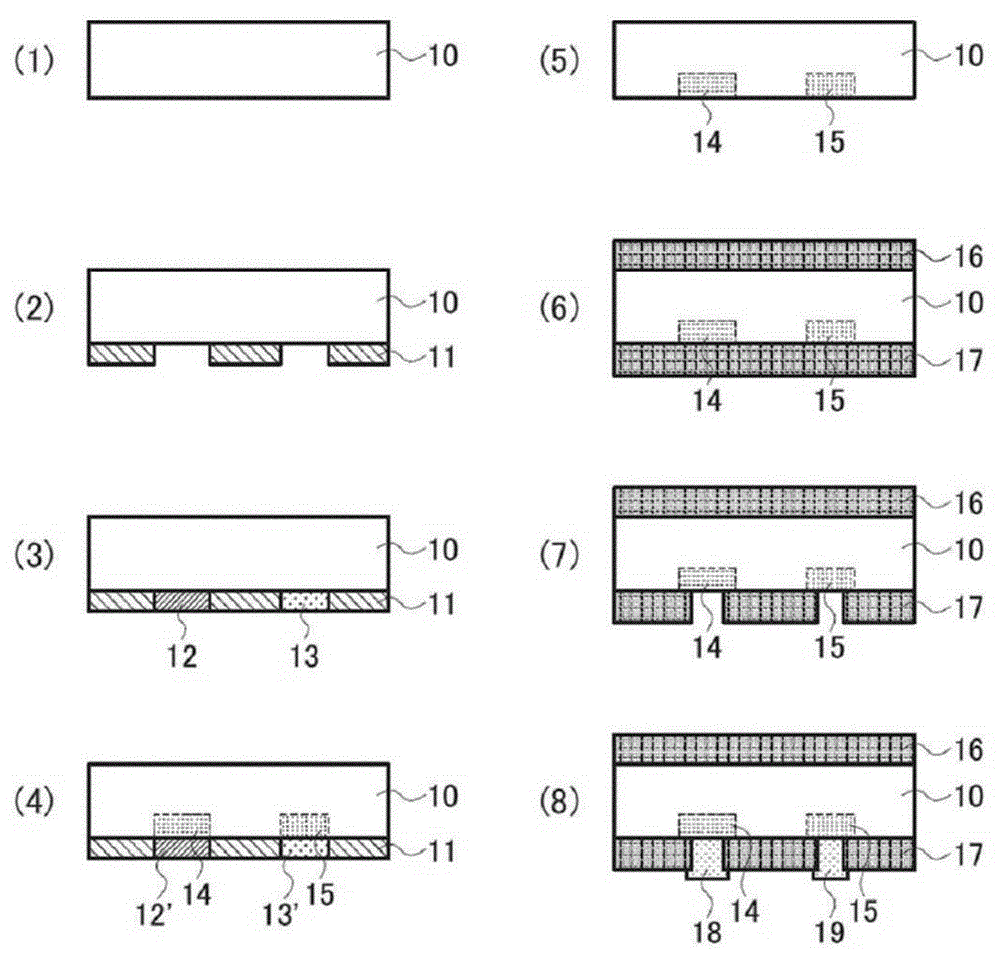Mask forming composition, production method for solar cell substrate, and production method for solar cell element
A technology of solar cells and manufacturing methods, applied in the direction of electrical components, semiconductor/solid-state device manufacturing, circuits, etc., can solve problems such as non-power generation
- Summary
- Abstract
- Description
- Claims
- Application Information
AI Technical Summary
Problems solved by technology
Method used
Image
Examples
Embodiment 1
[0123] (Preparation of composition 1 for mask formation)
[0124] 10 g of tetraethoxysilane (manufactured by Tama Chemical Industries, ethyl orthosilicate), 4 g of water, 0.1 g of nitric acid, and ethanol were mixed and stirred. Next, 10 g of magnesium oxide (manufactured by Wako Pure Chemical Industries, volume average particle diameter 0.2 μm, amorphous particles) was mixed in a mortar to prepare a composition 1 for mask formation. The viscosity of this mask-forming composition 1 at 25° C. and 5 rpm was 0.2 Pa·s. In addition, the viscosity was measured by using an E-type viscometer (manufactured by Tokyo Keiki) so that the sampling amount of the composition for mask formation was 0.5 ml.
[0125] (Preparation of Phosphorus Diffusion Solution)
[0126] A 20% by mass aqueous solution of ammonium dihydrogen phosphate (manufactured by Wako Pure Chemical Industries) was prepared, and a saturated aqueous ammonium dihydrogen phosphate solution of the supernatant was used as a pho...
Embodiment 2
[0134] A mask-forming composition 2 was prepared in the same manner as in Example 1, except that 10 g of calcium oxide (manufactured by Wako Pure Chemical Industries, volume average particle diameter: 2.5 μm, amorphous particles) was used instead of magnesium oxide. The viscosity of this mask-forming composition 2 at 25° C. was 0.15 Pa·s.
[0135] It evaluated similarly to Example 1 except having used the composition 2 for mask formation instead of the composition 1 for mask formation in Example 1. The sheet resistance of the portion coated with the mask-forming composition 2 was 150Ω / □.
Embodiment 3
[0137] 10 g of tetraethoxysilane (manufactured by Tama Chemical Industries, ethyl orthosilicate), 4 g of water, and 0.1 g of nitric acid were mixed and stirred. Next, 10 g of calcium carbonate (manufactured by Kopur Chemical, volume average particle diameter 2.0 μm, amorphous particles) and α-terpine dissolved in 15% by mass of ethyl cellulose (manufactured by Dow Chemical Company, STD200) were mixed in a mortar and mortar. 20 g of alcohol (manufactured by Terpene Chemical Co., Ltd.) and 5 g of α-terpineol were stirred well to prepare a composition 3 for mask formation. The viscosity of this mask-forming composition 3 at 25° C. was 0.2 Pa·s.
[0138] The composition 3 for mask formation was spin-coated on the n-type silicon substrate, and it dried at 150 degreeC. The subsequent steps were performed and evaluated in the same manner as in Example 1. The sheet resistance of the portion coated with the mask-forming composition 3 was 180Ω / □.
PUM
| Property | Measurement | Unit |
|---|---|---|
| Volume average particle size | aaaaa | aaaaa |
| Viscosity | aaaaa | aaaaa |
| Resistance | aaaaa | aaaaa |
Abstract
Description
Claims
Application Information
 Login to View More
Login to View More - R&D
- Intellectual Property
- Life Sciences
- Materials
- Tech Scout
- Unparalleled Data Quality
- Higher Quality Content
- 60% Fewer Hallucinations
Browse by: Latest US Patents, China's latest patents, Technical Efficacy Thesaurus, Application Domain, Technology Topic, Popular Technical Reports.
© 2025 PatSnap. All rights reserved.Legal|Privacy policy|Modern Slavery Act Transparency Statement|Sitemap|About US| Contact US: help@patsnap.com

